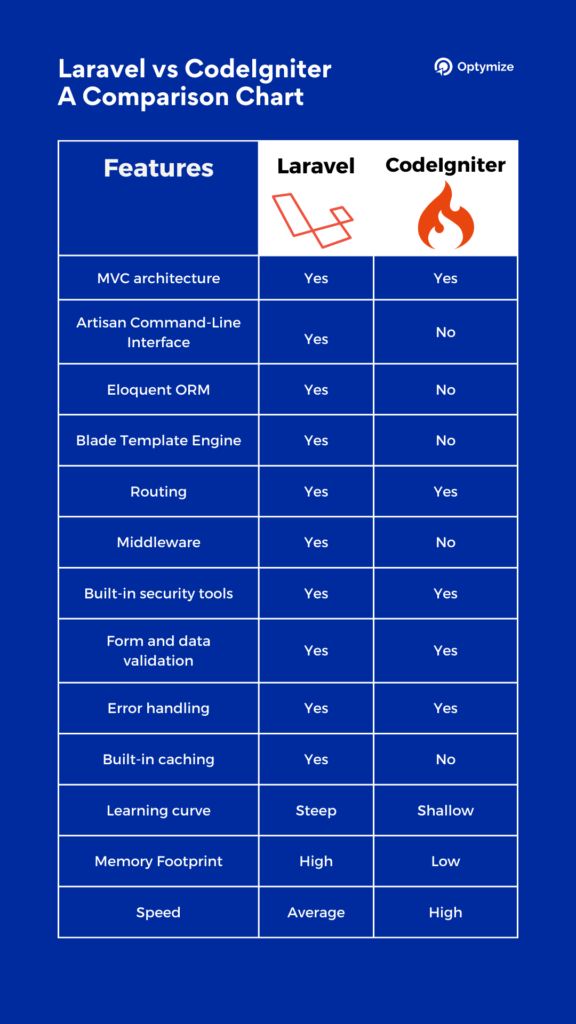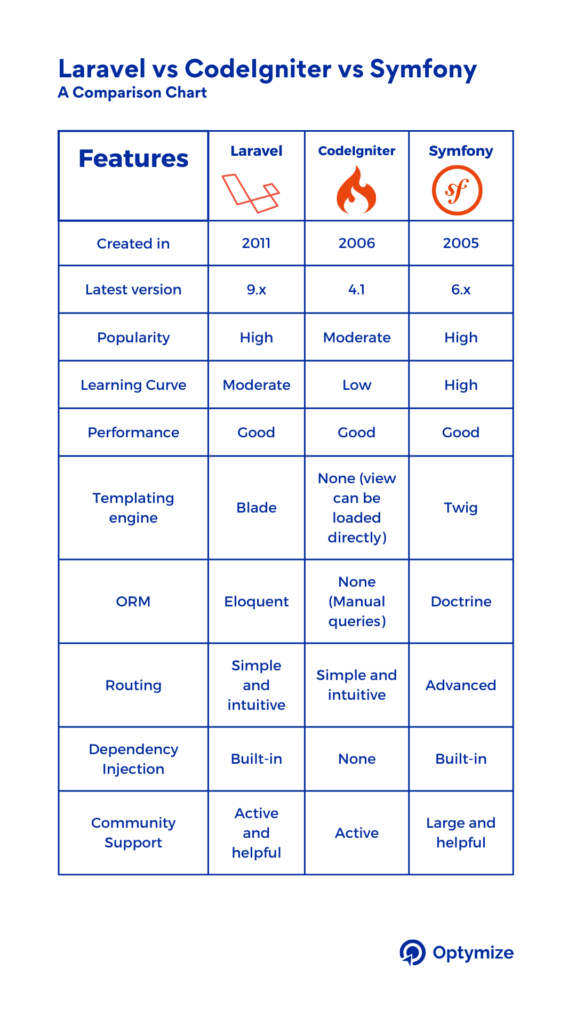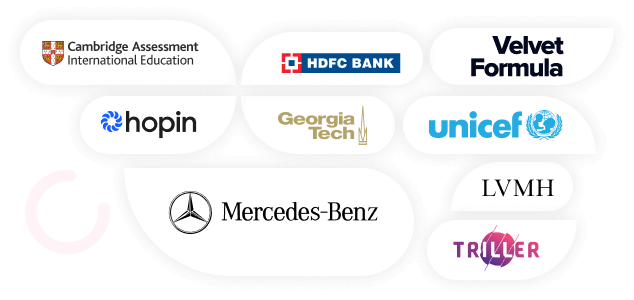When it comes to web development, there are a plethora of options to choose from. Two of the most popular frameworks in PHP web development are Laravel and CodeIgniter. Both frameworks have their own unique set of features and capabilities that make them suitable for different types of projects.
In this comparison, we will take a look at the main differences and similarities between Laravel and CodeIgniter to help you determine which framework is the best fit for your project.
CodeIgniter vs Laravel: Framework
CodeIgniter
CodeIgniter is an open-source PHP web application framework designed to create full-featured web applications. It is known for its small footprint, exceptional performance, and ease of use. It does not require any command-line interface or template language, making it a great choice for businesses who prefer a straightforward approach to web development.
Laravel
Laravel is an open-source PHP web application framework that is designed to make the development process pleasant without sacrificing application functionality. It is known for its clean syntax, elegant design, and built-in tools for common tasks such as routing, authentication, and caching.
Laravel provides an extensive set of features including the Artisan command-line interface, Eloquent ORM, and blade template engine, making it a popular choice among businesses who want a more robust framework for their projects.
Laravel vs CodeIgniter: Performance Benchmark
Performance benchmarking for Laravel and CodeIgniter is a complex topic and depends on a variety of factors such as server configuration, database design, and the specific requirements of the application. In general, both frameworks are known for their excellent performance and can handle high traffic and complex applications.
However, some developers may find that CodeIgniter has a slight edge in performance due to its smaller footprint and minimalistic approach to web development. CodeIgniter has a smaller codebase, which can result in faster loading times and lower memory usage.
On the other hand, Laravel is known for its advanced features, such as the Eloquent ORM, that can provide increased functionality and ease of use. Laravel also has built-in support for caching, which can improve performance in certain situations.
Performance benchmarking for Laravel and CodeIgniter can depend on several factors, including:
Server Configuration
The performance of both frameworks can be affected by the server’s hardware and software configuration. For example, using a powerful server with a fast CPU and sufficient RAM can improve the performance of both frameworks.
Database Design
The performance of the application can also be affected by the design of the database. Both Laravel and CodeIgniter use the Model-View-Controller (MVC) architecture, which separates the data model from the view and the controller. However, Laravel has a built-in ORM (Object-Relational Mapping) called Eloquent, which can improve the performance of the database operations.
Caching
Laravel has built-in support for caching, which can improve the performance of the application in certain situations. CodeIgniter does not have built-in caching support, but it can be added through third-party libraries.
Routing
Both frameworks have routing features, but Laravel uses a more advanced routing system that allows for more flexibility and customization.
Template Engine
Laravel uses the blade template engine, which can improve the performance of the application by caching the compiled views. CodeIgniter does not have a built-in template engine, but it can be added through third-party libraries.
Learning curve
Laravel has a steeper learning curve than CodeIgniter, and businesses may find it more challenging to get up to speed with Laravel’s advanced features.
Laravel vs Codelgniter: PHP Framework
Features of Laravel
Artisan Command-Line Interface
Laravel provides an easy-to-use command-line interface for generating boilerplate code and performing common tasks.
Eloquent ORM
Laravel’s Eloquent ORM is an advanced Object-Relational Mapping tool that allows you to interact with the database easily and elegantly.
Blade Template Engine
Laravel’s built-in template engine, Blade, allows you to create clean and reusable views with minimal code.
Routing
Laravel’s routing system is powerful, flexible, and allows for easy URL management and handling of different HTTP methods.
Middleware
Laravel’s middleware system allows developers to filter requests before they reach the controller, making it easier to handle authentication, authorization, and other tasks.
Features of CodeIgniter
MVC architecture
CodeIgniter follows Model-View-Controller (MVC) architecture, which separates the data model, the view and the controller.
Lightweight
CodeIgniter is known for its small footprint and minimalistic approach to web development.
Built-in security tools
CodeIgniter provides built-in security tools such as XSS filtering and CSRF protection.
Form and data validation
CodeIgniter provides built-in form validation and data validation features that make it easy to validate user input.
Error handling
CodeIgniter has robust error-handling features that make it easy to handle and debug errors in the application.
Laravel vs CodeIgniter – Speed and Memory
When comparing Laravel vs CodeIgniter, it is important to consider the performance factors of speed and memory usage. Both frameworks are known for their exceptional performance and ability to handle high-traffic and complex applications. However, there are some differences in terms of speed and memory usage between the two frameworks.
CodeIgniter boasts a smaller codebase and minimalistic approach, which results in a smaller memory footprint and faster loading times. This can make CodeIgniter a more suitable choice for projects that prioritize speed and memory efficiency.
On the other hand, Laravel offers advanced features such as the Eloquent ORM, which can provide increased functionality resulting in higher memory usage. Laravel also has built-in support for caching, which can improve performance in specific situations.
Laravel vs CodeIgniter: Comparison

Laravel vs CodeIgniter vs Symfony
Laravel, CodeIgniter, and Symfony are all popular PHP frameworks used to build web applications. Each of these frameworks has its strengths and weaknesses, and the best choice for a particular project will depend on the specific requirements of that project.
Laravel is a relatively new framework released in 2011. It has quickly gained popularity due to its elegant syntax, built-in support for modern web application features, and a large and active community. The latest version of Laravel is 9x. The framework has a moderate learning curve and good performance. Laravel uses the Blade templating engine, Eloquent ORM and the routing is simple and intuitive. It has built-in Dependency Injection and an active and helpful community.
CodeIgniter is an older framework released in 2006. It is known for its small footprint, simple setup, and easy-to-learn, easy-to-use syntax. The latest version of CodeIgniter is 4.1. It has a low learning curve and good performance. CodeIgniter doesn’t have any built-in templating engine, it loads views directly, it doesn’t have any ORM, and manual queries are used. The routing is simple and intuitive. it has active community support.
Symfony is also an older framework released in 2005. It is known for its flexibility, scalability, and a large ecosystem of components and libraries. The latest version of Symfony is 6x. It has a high learning curve and good performance. Symfony uses the Twig templating engine, Doctrine ORM and routing is advanced. It has built-in Dependency Injection and a large and helpful community.

Laravel vs CodeIgniter: Which is Better for PHP Development in 2023
As we move into 2023, it’s important to note that web development is not limited to any specific language or framework. Both Laravel and CodeIgniter are powerful choices for building a successful web application. While these technologies are free, the cost of web developers can be significant for small businesses and startups.
According to the StackOverflow Survey 2022, the median salary for a Laravel developer in 2021 was $55071 and increased to $69318 in 2022. Similarly, the median salary for a CodeIgniter developer in 2021 was $51888 and increased to $64572 in 2022. As a small business or startup, it’s important to consider the cost of development while building your ideal product.
At our company, we understand the importance of saving resources while building a successful product. We offer pre-vetted remote developers within 72 hours and provide the top 3% of web developers to turn your project into a success. Our developers come with a 15-day risk-free trial, and we also offer feedback sessions, project improvement sessions, and upskilling opportunities.
If you’re ready to take the next step in your web development project, please reach out to us. We’d be happy to discuss your project and help you choose the best technology between Laravel and CodeIgniter for your specific needs.
Laravel vs CodeIgniter: FAQs
Q: What is the main difference between Laravel and CodeIgniter?
A: The main difference between Laravel and CodeIgniter is the level of abstraction and the number of built-in features. Laravel is more advanced and feature-rich, with several built-in tools for modern web development, such as an ORM, a command-line interface, and a templating engine. CodeIgniter is more minimalistic, with a smaller footprint and a simpler syntax.
Q: Which framework is better for beginners, Laravel or CodeIgniter?
A: CodeIgniter is generally considered to be better for beginners, as it has a simpler syntax and a shallower learning curve. Laravel, on the other hand, has more advanced features and a steeper learning curve.
Q: Can Laravel and CodeIgniter be used together?
A: Yes, Laravel and CodeIgniter can be used together, but it would require significant effort to integrate the two frameworks, and it is not recommended unless there is a specific requirement.
Q: Is Laravel faster than CodeIgniter?
A: The performance of Laravel and CodeIgniter can vary depending on the specific application and the server environment, but generally speaking, both frameworks are known for their good performance. Laravel has more advanced features, but it may have a slightly higher overhead than CodeIgniter.
Q: Does Laravel have a built-in templating engine, like CodeIgniter?
A: Yes, Laravel has a built-in templating engine called Blade, while CodeIgniter does not have a built-in templating engine, views can be loaded directly.
Q: Which is more secure Laravel or CodeIgniter?
A: Both Laravel and CodeIgniter are known for their good security features, but Laravel has more built-in tools and functionality for securing a web application. Laravel offers built-in support for password hashing, encryption, and authentication, as well as tools for protecting against common web attacks such as cross-site scripting (XSS) and cross-site request forgery (CSRF). CodeIgniter also has security features but they are not as extensive as Laravel’s.





